Internment camps in France
Numerous internment camps and concentration camps were located in France before, during and after World War II. Beside the camps created during World War I to intern German, Austrian and Ottoman civilian prisoners, the Third Republic (1871–1940) opened various internment camps for the Spanish refugees fleeing the Spanish Civil War (1936–1939). Following the prohibition of the French Communist Party (PCF) by the government of Édouard Daladier, they were used to detain communist political prisoners. The Third Republic also interned German anti-Nazis (mostly members of the Communist Party of Germany, KPD).
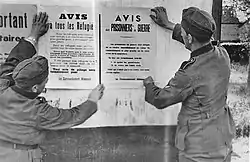
Then, after the 10 July 1940 vote of full powers to Marshal Philippe Pétain and the proclamation of the État français (Vichy regime), these camps were used to intern Jews, Gypsies, and various political prisoners (anti-fascists from all countries). Vichy opened up so many camps that it became a full economic sector, to the extent that historian Maurice Rajsfus writes: "The quick opening of new camps created jobs, and the Gendarmerie never ceased to hire during this period."[1] In any case, most of these camps were closed definitively after the liberation of France at the end of World War II. Some were however used during the Algerian War (1954–1962). Several of these were then used to intern harkis (Algerians who had fought on the French side) after the 19 March 1962 Évian Accords. Finally, the Camp de Rivesaltes in the Pyrénées-Orientales and the camp of Bourg-Lastic in the Puy de Dôme were also used to intern Kurdish refugees from Iraq in the 1980s.
Nineteenth century onward
First World War and later
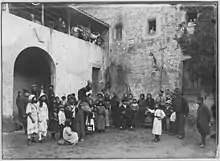
The first internment camps were opened during the First World War (1914–1918) to detain civilian prisoners (mainly German, Austro-Hungarian and Ottoman). These prisoners were detained in Pontmain in the department of Mayenne, Fort-Barreaux in Isère,[2]: 145–146 in the military camp of Graveson (Bouches-du-Rhône),[2]: 142–143 in Frigolet near Tarascon (Bouches-du-Rhône), Noirlac (Abbey) (Cher), and Ajain(Creuse).[2]: 142–143
Other internment camps were used for Armenians in the 1920s-1930s (Mirabeau camp, Victor Hugo camp and Oddo Camp in Marseille);[2]: 130 Gypsies after the 1912 Act on nomadism[2]: 132 (for instance in the Royal Saltworks at Arc-et-Senans, but also in iron mines in the Manche and other disaffected industrial centers in Mayenne, in the Manche, in Loire-Atlantique, in the Sarthe, in the Maine-et-Loire, etc.[2]: 45 ).
Spanish Civil War
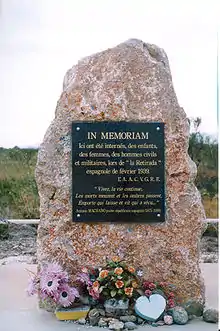
The most infamous internment camps before World War II were used to intern the Spanish Republican refugees and military personnel during the Spanish Civil War.[3] In 2 weeks in January and February 1939 around 500,000 men, women and children crossed the border.[4] These were interned mostly in camps in the Roussillon Province, such as the Camp de concentration d'Argelès-sur-Mer although internment camps for defeated Spanish Republicans were established in all of French territory, even in Brittany, in the north-west of France.[5] These camps were located in:
- Agde in the Hérault department (near Montpellier)
- Argelès-sur-Mer, between Perpignan and the border
- Camp Gurs in the Pyrénées-Atlantiques, which received Spanish refugees following the defeat of the Spanish Republic. These were distinguished by the French state into Brigadists, gudaris (Basque nationalists) who had escaped from the siege of Santander, pilots, and farmers. The latter had trades that were in low demand, and the French government, in agreement with the Francoist government, incited them to return to Spain. The great majority did so and were turned over to the Francoist authorities in Irún. From there they were transferred to the Miranda de Ebro camp for purification according to the Law of Political Responsibilities.
- Camp Vernet near Pamiers, in the Ariège.
- Moisdon-la-Rivière and Juigné-des-Moutiers in Loire-Atlantique department (Brittany).[6]
- The Camp de Rivesaltes, in the department of Pyrénées-Orientales. The Jewish detainees were sent to Drancy internment camp, near Paris, the Gypsies to Saliers and the Spaniards to camp Gurs.[7]
To these camps must be added the camps for the German prisoners in 1939 (sometimes overlapping with those above), and those of the Colonial Empire, not well known in Europe.
Furthermore, the Chilean poet Pablo Neruda, who had been named Consul in Paris for Immigration, organized the transportation to Chile of 2,200 Spanish refugees who had been detained in the camps on board the Winnipeg, which departed on 2 August 1939, and arrived in Valparaíso at the beginning of September 1939.
After 1940 when the Nazi Germany divided France in occupied and free zone, the camps were also used to imprison Jews, Gypsies, and sometimes gays, and the original prisoners were used as forced labor to make the camps larger.[4]
During World War II and the Vichy regime




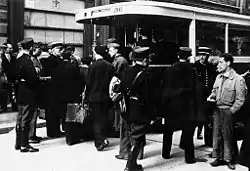
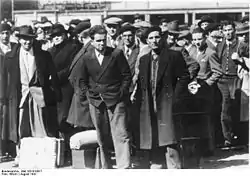
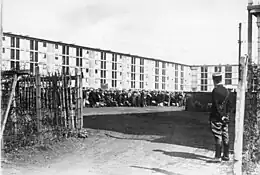



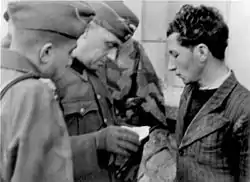
As early as 1939, the existing camps were indiscriminately filled with German anti-Nazis (Communists, German Jews, etc. Following the 1940 defeat, and the 10 July 1940 vote of full powers installing the Vichy regime, these camps were filled with Jews, first with foreign Jews, then indifferently with foreign and French Jews. The Vichy government would progressively hand them up to the Gestapo, and they would all transit by Drancy internment camp, the last stop before concentration camps in the Third Reich and in Eastern Europe and the extermination camps.
Beside Jews, Germans and Austrians were immediately rounded-up in camps, as well as Spanish refugees, who were later deported. 5,000 Spaniards thus died in Mauthausen concentration camp.[8] The French colonial soldiers were interned by the Germans on French territory, instead of being deported.[8]
The Third Republic and the Vichy regime would successively call these places "reception camps" (camps d'accueil), "internment camps" (camps d'internement), séjour camps (camps de séjour), "guarded séjour camps" (camps de séjour surveillés), "prisoner camps" (camps de prisonniers), etc. Another category was created by the Vichy regime: the "transit camps" ("camps de transit"), referring to the fact the detainees were to be deported to Germany. Such "transit camps" included Drancy, Pithiviers, etc. In particular, Pithiviers was used in 1941 for the green ticket roundup, and Drancy in 1942 for the Vel' d'Hiv Roundup, before the victims were deported.[9]
During the 1944 Battle of Marseille and urban scaping operations in the center of town, 20,000 people were expelled from their homes and interned during several months in military camps nearby Fréjus (La Lègue, Caïs and Puget).[2]: 129
The camp of Struthof, or Natzweiler-Struthof, in Alsace, one of the concentration camps created by Nazis on annexed French territory, included a gas chamber which was used to kill at least 86 detainees (mostly Jewish) with the aim of forming a collection of preserved skeletons for the use of Nazi professor August Hirt.
Second World War camps
- Aincourt, in Seine-et-Oise, was the first internment camp in the Northern Zone. It was opened on 5 October 1940, and quickly filled with members of the French Communist Party (PCF)[10]
- Les Alliers, near Angoulême, in Charente
- Royal Saltworks at Arc-et-Senans (Saline royale d'Arc-et-Senans) in the Doubs, used for Gypsies[11][12]
- Avrillé-les-Ponceaux in Indre-et-Loire, camp of the Morellerie for Gypsies
- Le Barcarès in the Roussillon
- Beaune-la-Rolande internment camp at Beaune-la-Rolande in the Loiret
- Bourg-Lastic in the Puy de Dôme, a former military camp where Jews were detained (André Glucksmann was detained there during four years). The camp was used to intern Harkis in the 1960s and Kurdish refugees from Iraq in the 1980s (see below).
- Bram in the Aude (1939–1940)
- Brens in the Tarn, near Gaillac (1939–1940)
- Choisel, in Chateaubriant in Brittany, in Loire-Atlantique (1941–1942)[13]
- Camp of Royallieu in Compiègne, Picardy (June 1941 to August 1944). It was used to intern the Jewish detainees arrested during the January 1943 Marseille roundup. Robert Desnos (1900–1945) and the famous French Resistance member Jean Moulin (1899–1943) transited through this camp.
- Coudrecieux in the Sarthe, was used to intern Romanis.
- Douadic in the Indre department
- Drancy internment camp: On 20 August 1941, French police conducted raids throughout the 11th arrondissement (district) of Paris and arrested more than 4,000 Jews, mainly foreign or stateless Jews. French authorities interned these Jews in Drancy, marking its official opening. French police enclosed a police barrack with barbed-wire fencing and provided Gendarmerie to guard the camp. Drancy fell under the command of the Gestapo Office of Jewish Affairs in France and German SS Captain Theodor Dannecker. Five subcamps of Drancy were located throughout Paris (three of which were the Austerlitz, Lévitan and Bassano camps)[14]
- Fort-Barraux in the department of Isère.[15] It had already been used as a prison during the French Revolution; Antoine Barnave was imprisoned there.
- Gurs internment camp in the Pyrénées-Atlantiques, created in 1939 for the Spanish refugees. During the Phony War, the Third Republic used it to intern "indésirables", that is Germans who were found in France, without regard to ethnicity or political orientation, as foreign citizens of an enemy power. Among them stands out a significant number of German Jews who had fled the very Nazi regime; citizens of countries who were in the orbit of the Reich, like Austria, Protectorate of Bohemia and Moravia, Slovak Republic, Fascist Italy, or Poland; French activists of the left (trade unionists, socialists, anarchists, and especially, communists), following the proscription of the Parti Communiste Français (PCF) by Daladier after the German–Soviet Non-aggression Pact; the first of these arrived 21 June 1940, and the majority were relocated in other camps before the end of the year. In Gurs were also interned during this period: anti-militarists, representatives of the French extreme right who sympathized with the Nazi regime, ordinary prisoners evacuated from prisons in the north of the country ahead of the German advance, common criminals awaiting trial. Then, under Vichy, Camp Gurs was used to detain foreign Jews, German Jews deported by the SS from southern Germany, persons who had illegally crossed the border of the zone occupied by the Germans, Spaniards fleeing Francoist Spain, Spaniards coming from other camps that had been condemned for being uninhabitable or due to their scarce contingent, stateless persons, people involved in prostitution, homosexuals, Romani people and indigents.
- Jargeau, near Orléans, used for the internment of Romani people
- Lalande in the Yonne,
- Linas-Montlhéry in the Seine-et-Oise for Romani people
- Marolles in the Loir-et-Cher
- Masseube in the Gers
- Les Mazures in the Ardennes department, where a Judenlager was opened from July 1942 to January 1944
- The Merignac internment camp in the Gironde. This is where Maurice Papon had Jews of the Bordeaux region interned before going to Drancy. Among others, Robert Aron was detained there.
- Meslay-du-Maine, in Mayenne department (1939–1940) (Leon Askin held here 1939)
- Camp des Milles near Aix-en-Provence in the Bouches-du-Rhône, which was the largest internment camp in the southeast of France. 2,500 Jews were deported from there following the August 1942 raids. Novelist Lion Feuchtwanger, Surrealist artists Hans Bellmer and Max Ernst were among the most famous inmates detained in this concentration camp.[16]
- Montceau-les-Mines
- Natzweiler-Struthof a German-run concentration camp located in the Vosges Mountains close to the Alsatian village of Natzwiller (German Natzweiler)
- Nexon in the Haute-Vienne
- Noé - Mauzac in the Haute-Garonne
- Montreuil-Bellay in the Maine-et-Loire, created to intern Romani people
- Les Tourelles in Paris
- Pithiviers transit camp in Pithiviers. Jewish novelist Irène Némirovsky (1903–1942) was interned there.
- Poitiers in the Vienne department to intern Romani people
- Port-Louis, in Morbihan, in the fort
- Recebedou, in Haute-Garonne, in the suburbs of Toulouse[17]
- Camp of Rieucros in Lozère (the mathematician Alexander Grothendieck was interned there)
- The Camp de Rivesaltes, in the Pyrénées Orientales, "The Drancy of the zone sud";[17]
- Fort de Romainville ("Fort of Romainville"), was a Nazi prison, located in the outskirts of Paris. The Fort was invested in 1940 by the German military and transformed into a prison. From there, resistance members and hostages were directed to the Nazi concentration camps: 3,900 women and 3,100 men were interned before being deported to Auschwitz, Ravensbrück, Buchenwald and Dachau. 152 persons were executed by firing squad in the Fort itself. A few escaped, such as Pierre Georges, alias "Colonel Fabien." From her cell, Danielle Casanova, motivated and encouraged her comrades to confront their torturers.[18] From October 1940, the Fort held only female prisoners (resistance members and hostages), who were jailed, executed or redirected to the Nazi concentration camps outside France. At the time of the Liberation in August 1944, many abandoned corpses were found in the Fort's yard.
- Saint-Cyprien in the Pyrénées-Orientales. 90,000 Spanish refugees were interned there in March 1939, and it was officially closed on 19 December 1940 for "sanitary reasons", its occupants transferred to the Camp of Gurs.[19]
- Saint-Maurice-aux-Riches-Hommes in the Yonne, for Gypsies
- Saint-Paul d'Eyjeaux in the Haute-Vienne
- Saint-Sulpice-la-Pointe. Located near Toulouse, this transit camp was set up after the beginning of the Phony War. It was to house "individuals representing a danger to national security" - mostly militant communists. In June 1940, with the first German attacks on the Soviet Union, people with Russian citizenship were interned there. Later, foreign Jews who had been living in hiding in the south of France and were rounded up in the summer of 1942 were also sent to the camp. The inmates, especially the communists, organized many cultural activities, a "little university", in which each one contributed their knowledge for the collective good. From the summer of 1942 to the closing of the camp in August 1944, most of its inmates were deported to camps in Eastern Europe, Auschwitz and Buchenwald.[20]
- Saliers concentration camp near Arles in the Bouches-du-Rhône, interned Romani people
- Schirmeck in Alsace in the part not annexed by the Third Reich
- Septfonds
- Thil in Meurthe-et-Moselle
- Le Vernet Internment Camp in the Ariège which concentrated 12,000 Spanish refugees as early as 1939. It was used later on for the internment of the harkis.
- Vittel in the Vosges department, where US or British citizens were interned
- Voves in the Eure-et-Loir
- Woippy in the department of Moselle, created in 1943.
Camps under foreign authorities
The Nazis also opened Struthof in Alsace (in the part annexed by the Reich).
The United States military police also possessed legal authority over the camp in Septèmes-les-Vallons, in the Bouches-du-Rhône.[2]: 53
Ilags
Ilag (for Internierunslager) were internment camps established by the German Army to hold Allied civilians, captured in areas that were occupied by the Germans. They included US citizens caught in Europe by surprise when the war was declared in December 1941 and citizens of the British Commonwealth caught in areas engulfed by the Blitzkrieg.
- Besançon in the Doubs (in the Vauban barracks). Also called Frontstalag 142, it was actually an internment camp. At the end of 1940, 2,400 women, mostly British, were interned in the Vauban barracks and another five hundred, old and sick, in the St. Jacques hospital close by. In early 1941, many of them were released, the rest were transferred to Vittel.
- Saint-Denis, near Paris. Located in the barracks, the camp was opened in June 1940 and remained in use until liberated by the United States Army in August 1944. Part of the grounds were surrounded by barbed wire to provide open space for exercise. In early 1942, there were more than 1,000 male British internees in the camp. The meagre food rations were augmented by the International Red Cross packages, so that overall their diet was satisfactory. Life was tolerable because there was a good library and recreation was provided by sports activities and theater[21]
- Vittel, Frontstalag 121 was located in requisitioned hotels in this spa near Epinal in the Vosges department. Most of the British families and single women were transferred here from Saint-Denis and Besançon. In early 1942, women over sixty, men over seventy-five and children under sixteen were released. The overall population was thus reduced to about 2,400. The inmates included a number of North-American families and women.
Colonial administration
Although not architecturally conceived as an internment camp, the Vel' d'Hiv (Winter Velodrome) was used during the July 1942 Roundup. Most internment camps, however, were not conceived as such.[2] The Vel d'Hiv was also used during the Algerian War (see below).
In the colonial empire, Vichy created in Algeria and in Morocco labour camps ("camps de travail") for Jews in:[22]
The liberation
German prisoners of war
Camps were also used after the liberation to intern German prisoners. In Rennes, after General Patton's United States Third Army liberated the city on 4 August 1944, about 50,000 German prisoners were kept in four camps in a city of 100,000 inhabitants at the time.
In the Camp de Rivesaltes, the German prisoners worked extensively in the reconstruction of Pyrénées-Orientales, between May 1945 and 1946, 412 German prisoners of war died in the camp.
After World War II
Indochina War
Internment camps were used to receive French from Indochina following the end of the Indochina War in 1954,[2]: 125–126 as well as approximatively 9,000 Hungarian refugees following the Budapest insurrection of 1956 (in Annecy, Colmar—Caserne Valter—, in Gap, in Le Havre, in Metz—Caserne Raffenel, in Montdauphin, in Montluçon—Caserne de Richemond—, in Nancy (camp de Chatelleraud), in Poitiers, in Rennes, in Rouen, in Strasbourg—caserne Stirn—and in Valdahon).[2]: 125–126 Humanitarian concerns largely intertwined with repressive aims, and internment restrictions and assistance given to populations varied widely (Hungarian refugees were better treated than French from Indochina[2]: 125–126 ).
Algerian War
Internment was also put to use during the Algerian War (1954–1962), generally under the name of "camps de regroupement" ("regrouping camps"). Within Algeria, the colonial administration used a form of camps as a counter-insurgency tactic, with up to 2 million civilians being internally deported in villages de regroupement[2]: 127 ) to prevent their falling under the influence of the opposing FLN forces. were brought to French metropolitan territory.
In France, some camps used under Vichy were opened again, in Paris in particular, to hold suspected FLN and other Algerian independentists.
The Harkis
Internment camps were also used to intern the Harkis (Algerians who fought on the French Army's side) after the 19 March 1962 Évian Accords which put an official end to the war. Finally, the Camp de Rivesaltes in the Pyrénées-Orientales, and Bourg-Lastic in the Puy de Dôme, used to intern Jews, were also used to intern Harkis in the 1960s, and Kurdish refugees from Iraq in the 1980s.
References
- Maurice Rajsfus, Drancy, un camp de concentration très ordinaire, Cherche Midi éditeur (2005).
- Bernardot, Marc (2008). Camps d'étrangers (in French). Paris: Terra. ISBN 9782914968409.
- Hugh Thomas, (1976). Historia de la Guerra Civil Española. Barcelona: Círculo de Lectores. ISBN 84-226-0873-1; p. 943
- Franco refugees still haunted by the past: ‘We were cold, hungry and scared’ The Guardian, 2019
- "Memoria Republicana - Imágenes - Corazón helado de 1939". Archived from the original on 18 February 2015. Retrieved 13 April 2017.
- Moisdon-la-Rivière - Les Espagnols Internés à Moisdon-la-Rivière Archived 2007-09-28 at the Wayback Machine and Le Camp de La Forge in Moisdon-la-Rivière
- "Redirection". Retrieved 13 April 2017.
- Film documentary on the website of the Cité nationale de l'histoire de l'immigration (in French)
- Grynberg, Anne (1991). Les camps de la honte: les internés juifs des camps français, 1939-1944 [Camps of shame: Jewish internees in the French camps, 1939-1944]. Textes à l'appui. Paris: La Découverte. p. 135. ISBN 978-2-7071-2030-4. OCLC 878985416., as quoted in Rosenberg, Pnina (10 September 2018). "Yiddish Theatre in the camps of the Occupied Zone". In Dalinger, Brigitte; Zangl, Veronika (eds.). Theater unter NS-Herrschaft: Theatre under Pressure [Theatre under NS rule: Theatre under Pressure]. Theater - Film - Medien (Print) #2. Göttingen: V&R Unipress. p. 297. ISBN 978-3-8470-0642-8. OCLC 1135506612. Retrieved 27 May 2020.
- Devaux, Fernand. "Aincourt, camp d'internement et centre de tri" [Aincourt, internment and sorting camp]. Al-Oufok (in French). Archived from the original on 14 July 2006.
- "Saline royale d'Arc et Senans (25) - L'internement des Tsiganes" (in French). Archived from the original on 21 May 2011. Retrieved 21 February 2007.
- Pigne, Manon (20 June 2011). "La Saline Royale d'Arc-et-Senans : un camp d'internement de la Seconde guerre mondiale" [The Royal Saltworks of Arc-et-Senans: a WW II internment camp]. Crimino corpus (in French). CNRS - ministère de la Justice.
- "Redirection". Retrieved 13 April 2017.
- United States Holocaust Memorial Museum. "Drancy" article for the Holocaust Encyclopedia (accessed 5 July 2009).
- "Le Centre de séjour surveillé de Fort-Barraux" (PDF). Retrieved 13 April 2017.
- "Listes des internés du camp des Milles 1941". Archived from the original on 22 July 2011. Retrieved 13 April 2017.
- "Liste des internés transférés à Drancy". Archived from the original on 22 July 2011. Retrieved 13 April 2017.
- Off, Lead. "Accueil - Mémoire et Espoirs de la Résistance". Archived from the original on 27 October 2005. Retrieved 13 April 2017.
- "Liste des internés transférés à Gurs". Archived from the original on 22 July 2011. Retrieved 13 April 2017.
- Saint-Sulpice-la-Pointe Camp Archived 18 May 2006 at the Wayback Machine (note confusion about dates concerning the Phony War)
- "III: Civilians in Europe | NZETC". nzetc.victoria.ac.nz.
- Satloff, Robert (2006). Among the Righteous: Lost Stories from the Holocaust's Long Reach into Arab Lands. New York: Public Affairs. p. 67. ISBN 1586483994.
Bibliography
- La SNCF sous l'Occupation allemande. Institut du temps présent, CNRS. 1996.
- Rajsfus, Maurice (2005). Drancy, un camp de concentration très ordinaire, 1941–1944. Le Cherche-midi éditeur. ISBN 2-86274-435-2.
- Steinbeck, Madeleine (January–March 1990). "Les camps de Besançon et de Vittel". Le Monde Juif. 137.
- Fontaine, Thomas (2005). Les oubliés de Romainville. Un camp allemand en France (1940–1944). Paris: Taillandier. ISBN 2-84734-217-6.
- Peter Gaida, Camps de travail sous Vichy, Lulu Press 2014
External links
- Concentration Camps in France Archived 22 November 2018 at the Wayback Machine at the online exhibition The Holocaust in France at Yad Vashem website
- Camps en France
- Souviens-toi des déportés - L'aide-mémoire de la déportation
- Souviens-toi des déportés - Les lieux d'internement avant les camps de concentration
- Map
- Map
- Exil ordinaire [Recherche]